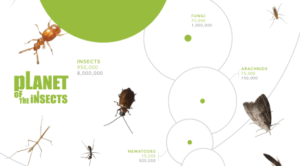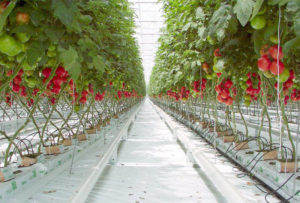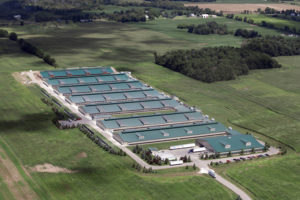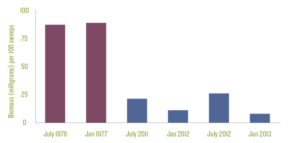Organic Regulations Are Being Exploited And As Consumers We Need To Support Better Farming Processes For a Better Food System
Many consumers are becoming more informed on the state of our current food system, but it is unfortunate that the growing Organic movement may be derailed by “Fauxganic” operations. CAFO’S (Concentrated Animal Feeding Operations), have been exposed as being disgusting ways to raise animals with horrible living conditions that cause disease and overuse of antibiotics and hormones. Non-organic farming has been exposed as being toxic because of GMO and carcinogenic pesticide use. This has caused people to turn to organic as a better and safer source of produce. What consumers don’t know, and farmers have been hesitant to go public with, is that the original organic certification that was created in the 1990’s has been infiltrated by big agribusiness and no longer holds the same meaning. Many foods that are labeled organic, are not being grown with true organic standards, i.e. pasture-raised animals not given hormones or antibiotics, produce grown in pesticide free-soil and so much more. The standards of the United States Department of Agriculture National Organic Program are as follows:
- Produced without excluded methods, (e.g., genetic engineering, ionizing radiation, or sewage sludge). Policy on genetically modified organisms (pdf)
- Produced using allowed substances. View the National List of Allowed and Prohibited Substances (National List).
- Overseen by a USDA National Organic Program-authorized certifying agent, following all USDA organic regulations.
The problem is that they allow certain CAFO’s to be considered organic, for eggs and dairy. The Cornicopia Institute has great guides on the which “organic” labels are actually worthwhile. Otherwise, it is best to shop at local farmers markets, or become part of a local farms CSA. They also provide a great guide on how to ask the right questions at farmers markets, and directly to farmers to find out if their produce is actually organic. They are also allowing hydroponic farming, which doesn’t use soil. This has the possibility to produce food that is tasteless and not as nutrient dense as things grown properly in chemical free soil. Also, all hydroponic operations are not created equal. We don’t know what they are feeding the plants!
A great organization that is trying to shed light on this issue is the Real Organic Project, who’s recent newsletter highlights in detail what is happening in the organic farming world. The National Organic Coalition is working in Washington to lobby for better certifications regulations and a move to support better practices that don’t try and cheat the consumer.
As consumers we need to not be scared of buying organic, or throw out the idea that organic is good, because of the agribusiness taking advantage of the certifications guidelines. We need to work towards better regulations, and support local farmers that are doing the right thing.
Insect Populations are Down Around the World And We Don’t Know Why
Insects make up the largest number of animals on our planet. Despite the fact that we think of them as mostly pests, they are crucial to many of the natural processes that create natural life for plants, other animals, and in turn humans. Close to one million insects species have been identified by scientists compared to the 5,416 mammal species, and there are supposedly thousands more out there. Insects pollinate a wide variety of plants, including many that humans eat. They are also important players in other natural jobs, which include breaking down dead things into the building blocks for new life, controlling weeds and providing raw materials for medicines, as well as providing sustenance for a spectrum of other animals. In a study done in Puerto Rico it showed that the decline of insects actually caused the ecosystem to decline  immensely because the animals that ate these bugs were dying off as well. The drop worldwide has been very significant according to the Ensia Non-profit reporting groups article:
immensely because the animals that ate these bugs were dying off as well. The drop worldwide has been very significant according to the Ensia Non-profit reporting groups article:
“Worldwide, a 2014 summary of global declines in biodiversity and abundance estimated a 45 percent drop in the abundance of invertebrates, most of which are insects. And many individual species and species groups are declining or even being threatened with extinction, from bumblebees in Europe and the United States to fungus weevils in Africa.”
The loss can’t be linked to any one widespread issue yet, but it is more localized and different for every group of insects and regions. It could be due to increased pesticides, and globalized industrialization and expansion of building and deforestation, as the effects of burning fossil fuels which are toxic, and an up tick in new insect diseases. The loss of insects could mean a huge decline in our environment, our food sources, and our natural resources as we know it.
Entomologist Helen Spafford proposes this plan for changing the public view. In the long haul, Spafford sees education as critical. “I think training teachers to better understand the role of insects in systems and such would be really helpful, and then teachers would hopefully share that information with students,” she says. “And then just helping the general public to understand the importance of insects in their daily lives, not just [as] pests but as important service providers.”
Ultimately we as the public (and the most powerful animals on this planet) need to change our perception of insects as “pests” and look at them as helpers.
In Midterm Election California Passes Historic Law Giving Animals Better Conditions on Farms 
Last week, California voters had to make a big choice, not just on their elected officials, but also on Proposition 12, a law to give farm animals better conditions. With an overwhelming outcome, voters passed the proposition with more than 61% of the vote in favor of the new law. This is great news, for not just California farmers and consumers, but consumers across the country, because this law requires all farms that sell to California markets to use these regulations. It requires farmers to raise chickens cage-free, giving them much more space to roam and live humanely. It’s far from perfect, but it is a big improvement!
According the Guardian the laws specific guidelines are:
“Beginning in 2020, the law will require that veal sold in the state comes only from calves who have more than 43 sq ft of space, and hens (including chickens, turkeys, ducks, geese and guinea fowl) will have to have at least one sq ft. Two years later, in 2022, the law will expand to include breeding pigs and their babies, banning the sale of pork unless it comes from pigs given at least 24 sq ft of space, and will require all eggs sold to come from “cage-free” hens, defined by the United Egg Producers’ guidelines.”
It also surpasses all previous legislation on the matter because it bans the sale of all farmers products that don’t abide by the rules. It also has a regulator part, which means that violators of the law will be found and investigated, and fined if they are violating the regulations. This is the most progressive animal welfare laws in the world currently, and shows that consumers do care how their food is produced and raised. It is important that we continue to stand up to the big business and support better practices across our food system. This win and new regulations is a great step towards a better system overall!




Comments are closed.